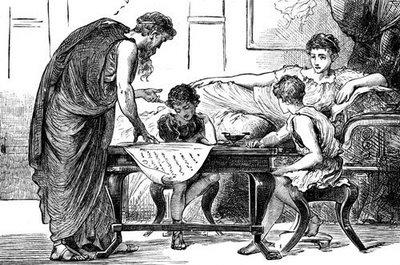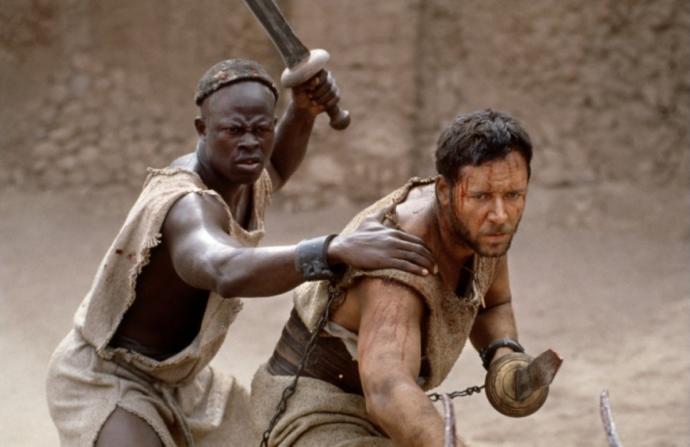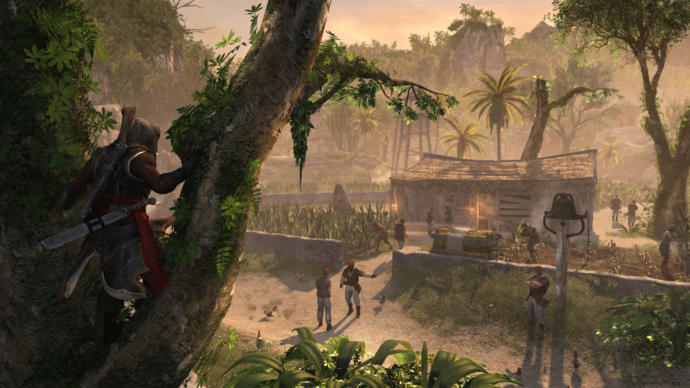The History of Slavery

Slavery enters human history with civilization. Hunter-gatherers and primitive farmers have no use for a slave. They collect or grow just enough food for themselves. One more pair of hands is one more mouth. There is no economic advantage in owning another human being.

Once people gathered in towns and cities, a surplus of food created in the countryside (often now on large estates) makes possible a wide range of crafts in the town. On a large farm or in a workshop there is the real benefit in a reliable source of cheap labor, costing no more than the minimum of food and lodging. These are the conditions for slavery. Every ancient civilization uses slaves. And it proves easy to acquire them.
War is the main source of supply, and wars are frequent and brutal in early civilizations. When a town falls to a hostile army, it is normal to take into slavery those inhabitants who will make useful workers and to kill the rest.
There are several other ways in which slaves are acquired. Pirates offer their captives for sale. A criminal may be sentenced to slavery. An unpayable debt can bring the end of liberty. The impoverished sell their own children. And the children of slaves are themselves, slaves - though with a cheap supply of labor available through war, not many owners will allow their slaves the diversion of raising a family.
Slaves in Babylon: 18th century BC
Information about slaves in early societies relates mainly to their legal status, which is essentially that of an object - part of the owner's valuable property. The Code of Hammurabi, from Babylon in the 18th century BC, gives chilling details of the different Rewards and penalties for surgeons operating on free men or slaves. But it also reveals that the system is not one of unmitigated brutality. Surprisingly, Babylonian slaves are themselves allowed to own property.
But the first civilization in which we know a great deal about the role of slaves is that of ancient Greece.
Slaves in Greece: from the 7th century BC

Both the leading states of Greece - Sparta, and Athens - depend entirely upon forced labor, though the system in Sparta is more properly described as serfdom rather than slavery. The distinction is that the helots of Sparta are a conquered people, living on their own hereditary land but forced to work it for their Spartan masters. Their existence is a traditional rural one to which certain rights remain attached.
The slaves of Athens, by contrast, have no conventional rights. But their condition varies greatly according to the work they do.
The most unfortunate Athenian slaves are the miners, who are driven often to the point of death by their owners (the mines are state-owned but are leased to private managers). By contrast, other categories of slaves - particularly those owned directly by the state, such as the 300 Scythian archers who provide the police force of Athens - can acquire a certain prestige.
The majority of Athenian slaves are domestic servants. Their fortune depends entirely on the relationship they develop with their owners. Often it is close, with female slaves looking after the children or acting as concubines, or a male slave running the household as a steward.

No free Athenian works in a domestic capacity, for it is considered shameful to be another man's servant. This inhibition applies equally to a subsidiary position in any form of business.
As a result, male slaves in Athens do all work of a secretarial or managerial nature, for in these contexts they are unmistakably somebody else's personal assistant. Such jobs include positions of influence in fields such as banking and commerce.
Slaves in Rome: from the second century BC
The same loophole, offered by the self-esteem of free citizens, provides even greater opportunities to slaves in imperial Rome. The most privileged slaves are the secretarial staff of the Emperor.
But these are the exception. In the two centuries before the beginning of the empire (the last two centuries BC) slaves are employed by Romans more widely than ever before and probably with greater brutality. In the mines they are whipped into continuing effort by overseers; in the fields, they work in chain gangs; in the public areas, they are forced to engage in terrifying combat as gladiators.

There are several slave uprisings in these two centuries, the most famous of them led by Spartacus.
Slaves in the Middle Ages: 6th - 15th century

In the period after the collapse of the Roman empire in the west, slavery continues in the countries around the Mediterranean. But the slaves are employed almost exclusively in households, offices, and armies. The gang slavery characteristic of large Roman estates does not reappear until the tobacco and cotton plantations of colonial America (one notable exception is the salt mines of the Sahara).
Nevertheless, the slave trade thrives, and the Mediterranean is a natural focal point.
More than anywhere else, the Mediterranean provides the geographical and economic environment to encourage a slave trade. Civilized regions surround the central sea. To the north and south stretch vast areas populated by relatively unsophisticated tribes. Border warfare results in tribal captives being enslaved. In addition to this, market forces encourage the tribes to seize prisoners of their own to serve a developing slave trade.
South of the Mediterranean, the dynasties of Arabs along the coast stimulate an African slave trade. The town of Zawila develops in the Sahara in about700 specifically as a trading station for slaves. Captured in the region around Lake Chad, they are sold to Arab households in a Muslim world which by the 8th century stretches from Spain to Persia.
Slavery is an accepted part of life in Arabia during the time of Muhammad, in the 7th century, and the Qur'an offers no arguments against the practice. It merely states, particularly in relation to female slaves, that they must be well treated. In general, that has been the case, compared with the barbaric treatment of slaves in some Christian communities.
in Christianity, it is said Slaves should obey their earthly masters as they would God. which shows its statement on the matter. During the early Middle Ages, the missionaries and bishops of the Roman Catholic church argue against the ownership of slaves in the emerging dynasties of northern Europe. At first, they make little headway. But gradually slavery disappears in western European countries - largely replaced by the serfdom of the feudal manor.
But a new and disastrous chapter in the story of slavery begins with the arrival of the Portuguese in West Africa in the 15th century.
Meanwhile, the Muslim habit of using slaves in the army has led to one unusual result - in itself, an indication of the trust accorded to slaves in Middle Eastern communities.
The Portuguese expeditions of the 15th century bring European ships for the first time into regular contact with sub-Saharan Africa. This region has long been the source of slaves for the route through the Sahara to the Mediterranean. The arrival of the Portuguese opens up another channel.
Some of these slaves are used to work the settlers' estates in the Cape Verde islands. Others are sent north for sale in Madeira, or in Portugal and Spain - where Seville now becomes an important market. Africans have been imported by this sea route into Europe since at least 1444, when one of Henry the Navigator's expeditions returns with slaves exchanged for Moorish prisoners.
The labor of the slaves in the Cape Verde Islands primes a profitable trade with the African region which becomes known as Portuguese Guinea or the Slave Coast. The slaves work in the Cape Verde plantations, growing cotton, and indigo in the fertile valleys. They are also employed in weaving and dyeing factories, where these commodities are transformed into cloth.
The cloth is exchanged in Guinea for slaves. And the slaves are sold for cash to the slaving ships which pay regular visits to the Cape Verde Islands.
This African trade, together with the prosperity of the Cape Verde Islands, expands greatly with the development of labour-intensive plantations growing sugar, cotton, and tobacco in the Caribbean and America. The Portuguese enforce a monopoly of the transport of African slaves to their own colony of Brazil. But other nations with transatlantic interests soon become the main visitors to the Slave Coast.

By the 18th century, the majority of the ships carrying out this appalling commerce are British. They waste no part of their journey, having evolved the procedure known as the triangular trade.
Triangular trade: 18th century
The triangular trade has an economic elegance most attractive to the owners of the slave ships. Each of the three separate journeys making up an expedition is profitable in its own right, with only the 'middle voyage' across the Atlantic involving slaves as cargo.
Ships depart from Liverpool or Bristol with items in demand in West Africa - these include firearms, alcohol (particularly rum), cotton goods, metal trinkets, and beads. The goods are eagerly awaited by traders in ports around the Gulf of Guinea. These traders have slaves on offer, captured in the African interior and now awaiting transport to America.
With the first exchange of merchandise completed, the slaves are packed into the vessels in appalling conditions for the Atlantic crossing. They are crammed below decks, shackled, badly fed and terrified. It is estimated that as many as twelve million Africans are embarked on this journey during the course of the Atlantic slave trade and that one in six dies before reaching the West Indies - where the main slave markets on the American side of the ocean are located.

The abolitionist movement: 1688-1808

The horrors of the slave trade do not go unnoticed in England, however hard the traders try to justify their activities (even, preposterously, proclaiming the care and consideration which they show to their precious cargo).
The first sharp prick to the public's conscience comes in 1688 with the publication of Aphra Behn's novel Oroonoko (about the sufferings of an African prince and his loved one, transported by the English to slavery in Surinam). By this time the Quakers are already prominent in their condemnation of this inhuman trade, with the society's founder, George Fox, speaking strongly against it. In 1772 there is a landmark case when Lord Mansfield frees James Somerset, belonging to an American master, on the grounds that he has set foot in England.
Shortly afterward, at the time of the American colonies' fight for independence, the Quakers again give a lead. The clamor for freedom, expressed so powerfully in the Declaration of Independence, can be seen as inconsistent in a population with a large African-American minority which is not in any sense free. The issue is starkly shown when the British troops fire on Patriots in the Boston massacre of 1770; the first man to fall in this demonstration for freedom is a slave, Crispus Attucks.
In 1774 Quakers in Britain decide to expel any member involved in the slave trade. In the same year Quakers in Pennsylvania sets up the first abolitionist society, and in 1776 the Pennsylvania Quakers free their own slaves. The first state to abolish slavery is Massachusetts, in its new constitution of 1780. Other northern states follow suit during the next few years.
But the southern states are determined to retain slavery, which is claimed to be an economic necessity (this rift becomes evident in the constitutional convention in Philadelphia). As a result, the abolitionists concentrate their efforts on abolishing the trade in slaves, assuming that this will have the gradual effect of ending slavery itself.

A book of 1786 by Thomas Clarkson (Essay on the Slavery and Commerce of the Human Species) is followed by the foundation in London in 1787 of the Society for the Abolition of the Slave Trade, with Quakers again predominant. William Wilberforce emerges as the champion of the cause in Parliament.
By a coincidence, the slave trade is declared illegal on both sides of the Atlantic in 1807. In America, the constitutional congress has agreed in 1787, under pressure from the southern states, that no law on slavery will be passed for twenty years. As soon as the agreed time is up, legislation is enacted - outlawing the slave trade from 1 January 1808. Meanwhile in London in 1807 Parliament prohibits the carrying of slaves in any British ship and the import of slaves into any British colony.
These prove hollow victories. Enough children are now being born into slavery to work the plantations, even in the rapidly expanding cotton economy of the southern states. The new cause must be the abolition of slavery itself.
The political issue of slavery: 1819-1850
Slavery has been a major area of disagreement between the northern and southern states ever since the first compromise is achieved on the issue at the constitutional convention of 1787. It becomes a particularly hot political issue in 1819 during congressional debates on the application of Missouri for statehood.
Settled largely from neighboring Kentucky, Missouri contains many slaves on the plantations. In 1819 a New York congressman, James Tallmadge, proposes an amendment to the Missouri bill to the effect that no further slaves shall be brought into the state and that children of existing slaves shall be freed at the age of twenty-five.
The house of representatives, with a preponderance of congressmen from the more populous north, passes the Tallmadge amendment. In the Senate, where eleven southern and eleven northern states have two senators each, the amendment fails to win a majority. It is an issue of great importance since the two new senators of a 'free' or a 'slave' state will tip the existing balance one way or the other.
The impasse is broken by another in the series of practical compromises on this contentious issue. It is agreed in 1820 that the district of Maine will be separated from Massachusetts to become an independent free state, the 23rd in the union. Missouri, with its slaves, follows in 1821 as the 24th. The balance is kept in the senate.
The Missouri Compromise, as the measures of 1820 become known, includes one other clause passed separately by Congress. This legislates in advance for the territory beyond Missouri, stating that no more slave states shall be admitted to the union north of latitude 36.30 (the continuation of the southern boundary of Missouri).
The compromise holds good for the next thirty years, during which an equal number of new slave and free states enter the union (Arkansas, Florida, and Texas in the south, Michigan, Iowa and Wisconsin in the north). But in 1849 the issue returns. California applies to join the union as a free state. For the first time since 1820, the southern states are in danger of being outvoted in the senate.
This time the compromise patched together is more complex, consisting of five separate agreements passed during 1850. Concessions to the north include the key issue of Californian admission to the union as a free state; and the banning of the slave trade (but not slavery itself) in the nation's capital city, Washington, and the surrounding district of Columbia.
Concessions to the south are the promise that when New Mexico and Utah are ready for statehood, they may enter the union either with or without slavery; the federal payment of $10 million dollars of Texan debt; and new and more stringent Fugitive Slave Laws.
The Fugitive Slave Laws, passed in 1793, have been a continuing cause of local friction. They allow southern slave owners to reclaim escaped slaves found in northern states. Northern magistrates have often made a policy of deliberately frustrating the slave owners' legal rights in this respect. The Fugitive Slave Laws of 1850 attempt to prevent this (though in practice they have the opposite effect, prompting northern states to pass new laws safeguarding liberty).
It is believed by many that the Compromise of 1850 will resolve the thorny issue. It does nothing of the kind. Within four years the question of Kansas escalates the crisis.
Emancipation Proclamation: 1862-1863
President Lincoln has undertaken the Civil War intending only to preserve the Union. His purpose and that of the Republican Party has never been to end slavery in the southern states. and the Democratic party were sure as hell not going to give it up. But two costly and inconclusive years of war begin to alter his opinion.

There are several reasons. The abolitionist lobby in the north is passionate and vocal. Increasing resentment at the southern states, begetters of this painful conflict, lessens any inclination to protect their supposed rights as slave-owners. And a new moral dimension added to the Union war aims is likely to bring its own diplomatic and political benefits.
Liberal opinion in Britain, where the government often seems inclined to support the south, will be impressed by an anti-slavery crusade. And flagging domestic acceptance of the war will be refreshed by an injection of idealism, particularly in the cause with which Americans identify most powerfully - that of liberty.
Lincoln decides, in the summer of 1862, to make the emancipation of the slaves a central plank of his policy. But this summer, bringing successive defeats in Virginia of Union armies, seems not the right moment. It is important that such an important announcement shall not seem to be made in desperation.
The president is given his opportunity when the engagement at Antietam, in September 1862, can be presented as a Union success on the battlefield. Five days later he issues a preliminary proclamation. It states that if the Confederate states have not laid down their arms by the end of the year, he will declare their slaves to be free.

Naturally, the states fail to respond, so on 1 January, 1863 Lincoln issues his Emancipation Proclamation. It declares that all people held in slavery in the rebel states are now free; it urges them to refrain from violence, and it announces that freed slaves will be welcome to serve in the US army and navy.
Most of this is as yet only of symbolic relevance. No slaves have formally freed anywhere since the proclamation does not apply to slave states fighting on the Union side (where Lincoln cannot as yet afford to offend their owners). Nevertheless, many southern slaves take the opportunity to flee to the north. By the end of the war, about 180,000 African-Americans have joined the armed forces, greatly boosting Union military strength.
And the symbolic effect is enormous. The struggle now has a high moral purpose. The attitude of the slaves is transformed, whether in Union or Confederate states, by the knowledge that a Union victory will be followed by freedom.
furthermore, the Empire of Britain takes a large stance against slavery by outlawing it everywhere they hold power which was about 2/3rds of the world. and they just about abolished it completely.
Among the last states to abolish slavery, were Saudi Arabia and Yemen, which abolished slavery in 1962 under pressure from Britain; Oman in 1970, and Mauritania in 1905, 1981, and again in August 2007.
This, however, is mainly the history of slavery in the West it has gone on across the world and
It still exists in Africa however and many places just not in the open like it once was.
Every race has been enslaved at one point. and one day may return to practice if we don't Stand together against it. no one owes anyone reparations but we all owe each other basic human dignity and to not try and own each other.

 Holidays
Holidays  Girl's Behavior
Girl's Behavior  Guy's Behavior
Guy's Behavior  Flirting
Flirting  Dating
Dating  Relationships
Relationships  Fashion & Beauty
Fashion & Beauty  Health & Fitness
Health & Fitness  Marriage & Weddings
Marriage & Weddings  Shopping & Gifts
Shopping & Gifts  Technology & Internet
Technology & Internet  Break Up & Divorce
Break Up & Divorce  Education & Career
Education & Career  Entertainment & Arts
Entertainment & Arts  Family & Friends
Family & Friends  Food & Beverage
Food & Beverage  Hobbies & Leisure
Hobbies & Leisure  Other
Other  Religion & Spirituality
Religion & Spirituality  Society & Politics
Society & Politics  Sports
Sports  Travel
Travel  Trending & News
Trending & News
What Girls & Guys Said
Opinion
1Opinion
Awesome piece, I skimmed the whole thing because I could read all that haha. I liked how you mentioned the Missouri Compromise and Compromise of 1850, showing the norths attempts to appease the south and keep them together from seceding. A solid unbiased stand point of history which is how it should be, un-editorialized!
Share the first opinion in your gender
and earn 1 more Xper point!